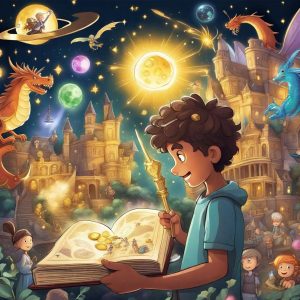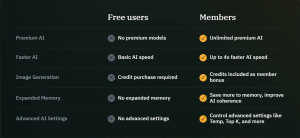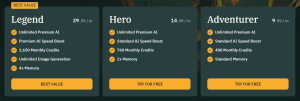7 How To Use AI Dungeon To Create Interactive Stories
Vincent Santiago

Image created with Nightcafe image generator.
Prompt:
a student amazed because they are seeing a book glow and shine as a bunch of fairies, dragons, space ship, knights, swords, gold coins, jewelry, computer, scientist, map, pirates, stars, sun, moon, detectives, flashlight, books and random objects come out of a book
Introduction
No rules, no objective. Only adventure. (AI Dungeon)
AI Dungeon is a text-based, AI generated fantasy simulation with infinite possibilities. Unlike most games where you experience worlds created by game designers, with AI Dungeon, you can direct the AI to create worlds, characters, and scenarios for your character to interact with. You can lead an army fighting back an alien invasion. Or be a mythical detective investigating the attempted assassination of the fairy queen. Maybe even make the stories about your life and introduce the characters as your friends going on an adventure, whatever genre that may be. (AI Dungeon)
By allowing the users to have free reign, users have the chance to experience immersive and interactive story telling entertainment; shaping their stories and ideas by their choices and actions.” AI Dungeon allows us to see just how powerful generative AI is, especially language models like GPT-3, where it creates human like storytelling.
AI Dungeon relies on 3 AI language models:
- Griffin – Griffin is our fastest model and features the largest memory options. This model offers interesting and unexpected outputs and is available to all players.
- Dragon – Dragon is our largest language model and offers complex writing capabilities with fewer retries but has slower generation speeds and smaller memory. This model is only available to subscribed players.
- ChatGPT through Microsoft Azure – ChatGPT though Microsoft Azure is a newer model in AI Dungeon. It performs extremely well in Adventures. Subscribed players have unlimited access to ChatGPT, while non-subscribed players receive a limited amount of daily ChatGPT actions.
With that said, and with all kinds of generative AI, there are those who are still uncertain about this technology. The content that is being generated can be controversial or unpredictable. That is why if we are going to use it in our classroom, there needs to be guidelines set to ensure that it is being used responsibly.
Connection to Curriculum
With AI Dungeon, it has a role in critical media literacy by being the flatform that students engage and interact with in many forms. AI Dungeon allow students to be critical thinkers when consume and creating content use generative AI. Having the students to analyze stereotypes that come with using generative AI in the classroom. AI Dungeon empowers students to be responsible when using technology and have a deeper understanding the role AI has in shaping the many outcomes it can create. Students can work in reverse and examine each of the steps they have created to achieve the outcomes of what they are prompting the GAI to create. By using GAI in the classroom, like AI Dungeon to create interactive stories, it allows the students to increase their knowledge of the internet and technology. AI Dungeon can also aid students in their creative writing and their language comprehension when creating their own story.
Visual Arts Outcomes:
CP30.1 – Purposefully select and manipulate media and image development strategies to express ideas demonstrating personal style and voice.
- (a) Select and apply design, composition and image development strategies to enhance personal voice and style, considering, for example:
Sample Image Development Strategies
- abstract
- animate
- disguise*
- distort
- etc.
Indicators:
- (c) Evaluate/critique own ideas and select the best to transform into a visual art product.
- (f) Collaborate with peers to develop criteria for critique.
What can that look like:
- Base of the narrative that the students have created, students can create what is happening in that moment of the story. Students can apply different styles and media in their image that they are creating for their story creating different affects and show off their own artistic styles.
- It can be fantasy story with dragons and fairies, but students make it their image style futuristic, with Van Gogh style, with crayon as the medium.
- You can also see the students’ own artistic styles in what they put as their prompt to create their image.
- With end product and working with their classmates, students can reflect on what they can change to create a different outcome with their story and with their images.
Biology Outcomes:
BI30-OL1 – Investigate cell structure and processes, including energy transfer and transport of materials, in unicellular and multicellular organisms which are representative of each kingdom.
Indicators:
- (b) Analyze the processes (e.g., chemosynthesis, photosynthesis and cellular respiration) through which organisms from each kingdom synthesize energy in the form of adenosine triphosphate (ATP). (K)
- (c) Describe how biologically important molecules work together to form complex structures (e.g., cell membranes, ribosomes and deoxyribonucleic acid [DNA]). (K)
- What can that look like:
- You can have the students narrate a step by step of how the processes work from the beginning to the end of a process. Narrate a story of how a white blood cell fights off viruses and how it can’t kill a cancer cell. Or things such as how we gain our energy and how much energy we gain from eating certain foods, starting from the main source of energy, the sun.
- By creating a story from it, it shows us how students are comprehending the material we are giving to them. And how they are telling how the processes are happening.
Affordances and Constraints
AI Dungeon is “Free to play.” There are some options that allow you to do more when creating your interactive stories and it is going to cost you. A big downside to not being a member is that you don’t have access to Image Generation. Which is a great deal as it would be interesting to see how students visually think. As well as what the students see come to life when they are going through their interactive stories. And overall, for you as a teacher to see what kind of prompt students put and how they create their prompts.
The Process
AI Dungeon’s simple step by step on how to start creating your own interactive stories.
- Define your world
- Pick a character, a world, and a story. The AI will fill in the details for your unique adventure. Or choose predefined worlds from other users, or a random one using quick start.
- Take actions
- You can decide what your character says or does. The AI will produce responses from other characters, or world events for you to respond to. Every adventure is unique and unexpected.
- Make it yours
- Save the scenario for later. Don’t like the AI generated text? Initiate a re-do or enter your own words. You are the main character AND director of the adventure.
Getting to know more about AI Dungeon, there is a bunch of tips that will help you create your stories.
Different input modes: Do/Say/Story/See
- Do – Have your character perform an action.
- Say – Have your character say what you type in.
- Story – Have the AI respond to your own narration.
- See – Have the AI generate an image.
Basic of Prompt Engineering for creating Images
- When constructing your prompt, start with the kind of image you want: a water colour painting, a close-up photo, a pencil sketch, etc.
- Then, list adjectival modifiers with what they are modifying: red flag, stone wall, dramatic lighting, etc.
- Now add the main subject of your picture, what you want seen in the foreground: ship, castle, dragon, etc.
- Describe the background: in a forest, on the beach, above the clouds, etc.
- List specific art style(s) you’re after: art nouveau, cyberpunk, pop art, etc.
- Include terms about quality: sharp, beautiful, intricate, etc.
- Finally, put the artist(s) you’d like the AI to mimic: by Van Gogh, by Donato, by Michelangelo, etc.
Prompt Engineering (Ai Dungeon, n.d.)
With the different input modes, it allows the users to add more details and create a better response for there interactive story.
Anything that you type in DO mode is recognized by the AI as an action performed by your character, and it reacts by generating the outcome of that action within the context of the story.
You can use DO to input more interesting Say actions; shout, cry, ponder, or even combine actions while saying something.
The AI treats Say inputs similarly to Do inputs, so anything you type is recognized by the AI as a speaking action perform by your character, and it reacts by generating a response to that action within the context of the story.
If you only use DO and Say modes during your gameplay, the AI is more likely to generate repetitive sentences that always start with ‘You.’ To avoid this, we recommend varying your inputs between Do, Say, and Story; this will encourage the AI to generate a wider variety of sentence types throughout your adventure.
In Story, the inputs are treated the same as AI outputs, so no icon appears next to these actions in the game screen. If you combine the Story inputs with Do and Say to guide the AI during your adventures, or they can be used entirely on their own to create standalone stories without any ‘game’ like-elements.
If you want to get creative, add more details to your inputs, simple inputs will get simple responses from the AI.
When generating your images, See, list information from most important, what makes up more of your image (medium and foreground) to least (various details). The AI considers the beginning of your prompt first and may forget the end if the prompt is too long.
When generating photo-realistic images, always talk about the LIGHTING: dramatic, high-key, low-key, etc.
When structuring your prompt, it is also helpful to list information from biggest to smallest: [Medium] of [Subject] in [Style] with [Details] by [Artist(s)]
Recommendations
You can join a Discord group for extra information and a community of creative story tellers. As well as reach out to the Team members of AI Dungeon and ask questions. And play with others through the multiplayer option to create stories together. https://discord.com/invite/BFuH8mSSYM
You can also take a look at this PowerPoint, that is also provided by AI Dungeon themselves as an extra resource in image prompting. https://pitch.com/v/DALL-E-prompt-book-v1-tmd33y/6fb6f14b-10ef-48f3-a597-d4af7aa1c9c6
Informative presentation
 Learn more about How to Use AI Dungeon to Create Interactive Stories by clicking the image above.
Learn more about How to Use AI Dungeon to Create Interactive Stories by clicking the image above.
References
AI Dungeon. (n.d.) https://play.aidungeon.com/
Nightcafe. (n.d.) https://creator.nightcafe.studio/
Acknowledgement of AI Use
Creating this chapter, I used AI Dungeon to create an example to show how it is used and the processes that is happening. I have also used another AI engine, Nightcafe, to create my image at the beginning of the chapter.



